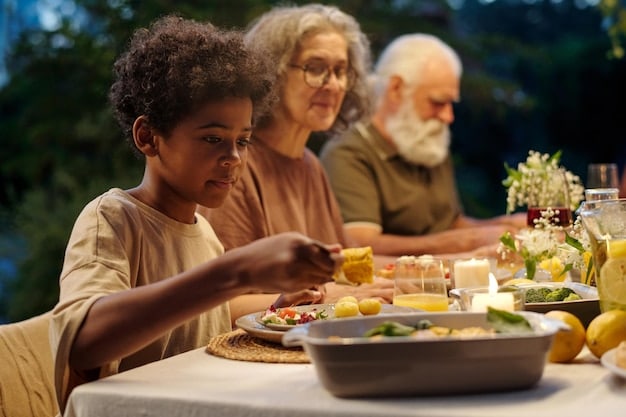US Individualism vs. Collectivism: Impact on Relationships

The dichotomy between individualism and collectivism profoundly shapes US relationships, influencing everything from personal autonomy to community engagement and understanding these differing perspectives is essential for navigating social dynamics effectively within American culture.
Delving into the intricate dynamics of American social fabric reveals a fascinating interplay between two powerful cultural forces: Understanding US Perspectives on Individualism vs. Collectivism: How It Impacts Relationships. This exploration is not merely academic; it offers profound insights into how Americans connect, form bonds, and navigate their personal and professional lives.
The Core Tenets: Defining Individualism and Collectivism
The foundational concepts of individualism and collectivism offer a lens through which to view American society, illustrating how deeply ingrained these philosophies are in everyday interactions. While often presented as opposing forces, their influence in the US is more nuanced, creating a complex social tapestry. This section will outline the primary characteristics of each concept.
What is Individualism?
Individualism, at its heart, emphasizes the moral worth of the individual. In the US, this translates to a strong belief in personal freedom, self-reliance, and independent thought. The American Dream, for instance, is a powerful narrative rooted deeply in individualistic ideals, pushing individuals to achieve success through their own efforts.
- Autonomy: A high value is placed on personal choice and self-direction in life decisions.
- Self-Reliance: Individuals are expected to be financially, emotionally, and socially independent.
- Personal Achievement: Success is often measured by individual accomplishments and merit.
This focus on the individual can manifest in various ways, from career choices to personal relationships. It champions the idea that one’s destiny is largely within their own control, fostering a spirit of innovation and entrepreneurship. However, it can also lead to a perception of isolation or lack of community support if not balanced with other values.
Understanding Collectivism’s Role
Collectivism, conversely, stresses the interdependence of individuals within a group, prioritizing group goals over individual desires. While less dominant than individualism in the US, collective tendencies are certainly present and influential, particularly within certain communities or social contexts.
- Group Harmony: Emphasis on maintaining peace and consensus within family, community, or workplace groups.
- Interdependence: Recognition of mutual reliance among members of a social unit.
- Shared Responsibility: A sense of collective duty and support for one another, especially in times of need.
For example, tightly-knit ethnic communities, religious organizations, or even sports teams frequently exhibit strong collective values, where group cohesion and shared identity are paramount. Recognizing these collective pockets is crucial for a complete understanding of American social dynamics, as they often provide a vital support system for their members. The interplay between these core tenets is what truly defines the unique flavor of US relationships.
Historical Roots: Shaping American Individualism
The prevailing individualistic ethos in the United States is not an accidental phenomenon; it is deeply embedded in the nation’s historical trajectory and foundational principles. Understanding these roots provides critical context for how Americans perceive personal relationships and broader societal obligations. The journey from colonial aspirations to modern-day self-perception reveals a continuous reinforcement of the individual over the collective.
From Frontier Spirit to Self-Made Man
The concept of the “frontier spirit” played a monumental role in shaping American individualism. Early settlers and pioneers often faced immense challenges alone or in small family units, far from established communities. This environment necessitated independence, resilience, and problem-solving, fostering a culture where self-reliance was not just a virtue but a necessity for survival.
This foundational experience evolved into the enduring myth of the “self-made man” or “self-made woman,” a narrative that celebrates those who achieve success through sheer hard work and determination, often without inherited wealth or significant external support. This narrative continues to inspire and motivate, but also subtly reinforces the idea that individuals are solely responsible for their own outcomes, both positive and negative. The lingering influence of the frontier and the self-made narrative helps to explain contemporary US attitudes towards personal responsibility and resilience.
Philosophical Underpinnings and Manifest Destiny
The philosophical bedrock of the United States—rooted in Enlightenment ideals of liberty, individual rights, and limited government—further cemented individualism. Thinkers like John Locke, with his emphasis on natural rights, heavily influenced the Founding Fathers. The Declaration of Independence, with its assertion of unalienable rights to “Life, Liberty, and the pursuit of Happiness,” is a quintessential expression of individualistic philosophy.
Coupled with this was the powerful concept of Manifest Destiny, which, while geographical in its initial thrust, also carried an individualistic undertone. It implied an individual’s right and even duty to explore, settle, and claim new territories, reinforcing personal agency and the pursuit of individual opportunity. These philosophical and historical forces created a fertile ground for individualism to flourish, eventually becoming a defining feature of the American character. This historical context illuminates why concepts such as personal freedom and self-determination remain central to the American psyche, impacting how relationships are formed and sustained.
The Impact on Romantic Relationships in the US
The strong currents of individualism in the US profoundly influence the landscape of romantic relationships, often shaping expectations, commitment levels, and even daily interactions. This cultural emphasis on the self can lead to both unique strengths and significant challenges within partnerships. It prompts a constant negotiation between personal desires and shared responsibilities within a couple.
Prioritizing Personal Fulfillment and Autonomy
In a culture that champions individualism, personal happiness and self-fulfillment often become paramount in romantic unions. Individuals seek partners who enhance their personal journey, rather than solely fulfilling traditional roles. This translates into a desire for relationships that support individual growth, career aspirations, and personal interests.
- Individual Growth: Partners value the opportunity to develop personally even within the relationship.
- Autonomy in Decision-Making: Expectation of shared or independent decision-making, rather than one partner dictating choices.
- Personal Space: A strong need for personal time, hobbies, and social circles separate from the partner.
This emphasis means partners might maintain separate bank accounts, friendships, or even pursue distinct career paths, seeing their relationship as a supportive framework for their individual lives. While this can foster strength and independence, it can also lead to conflicts if not clearly communicated.
Challenges with Commitment and Interdependence
The individualistic drive can sometimes clash with the inherent interdependence required for deep, lasting romantic commitment. Fear of “losing oneself” in a relationship or a perceived threat to personal freedom can make profound connection challenging for some. The concept of “me time” can sometimes overshadow “we time.”
Traditional notions of sacrifice for the partnership might be reframed as a compromise of individual autonomy, leading to potential friction. Discussions around division of labor, shared goals, and future planning require careful navigation as each partner balances their individual desires with the needs of the unit. Despite this, many US relationships find a harmonious blend, demonstrating that while individualism often sets the stage, it does not preclude deep emotional bonds and mutual reliance. The successful navigation of these dynamics often defines the longevity and health of romantic partnerships in the US.
Family Dynamics: A Blend of Old and New
Family structures and dynamics in the US often represent a fascinating blend of traditional collective values and modern individualistic tendencies. While the nuclear family remains a prominent ideal, broader societal shifts and diverse cultural backgrounds contribute to a complex, evolving landscape. This section explores how individualism and collectivism intersect within American family life, influencing everything from living arrangements to care for elderly relatives.
Nuclear Family Focus vs. Extended Kin Networks
Historically, the American ideal has largely centered around the nuclear family unit – parents and their children living independently. This model aligns well with individualistic values, promoting self-sufficiency and emotional autonomy within the household. Children are often encouraged from a young age to develop independence and eventually “leave the nest” to forge their own paths.

However, extended family networks, while perhaps less visible than in more traditionally collective societies, play a vital role for many American families. This is particularly true within immigrant communities where collectivist values from their countries of origin often persist, emphasizing kinship bonds, mutual support, and shared responsibilities across generations. These networks provide crucial emotional, financial, and logistical support, often blurring the lines between nuclear and extended family obligations.
Caregiving and Independence in Later Life
The implications of individualism versus collectivism are strikingly evident in how Americans approach caregiving for elderly family members. The individualistic ideal often promotes independence in later life, with older adults ideally living autonomously for as long as possible, often in their own homes or independent living facilities. This contrasts with more collective cultures where multi-generational households and direct family care are standard.
Decisions around aging parents’ care often involve complex discussions about personal autonomy, financial resources, and the perceived “burden” of care. While families invariably step in to support their elders, the expectation of individual responsibility often remains strong, influencing choices about nursing homes, home healthcare, and the division of caregiving labor among siblings. This ongoing negotiation highlights the constant tension and delicate balance between the desire for individual independence and the inherent collective responsibility within family units in the US. Ultimately, the reality is a continuum, with families adopting approaches that reflect their unique circumstances and cultural heritage.
Workplace and Social Interactions: Navigating Group Dynamics
The American workplace and broader social interactions are fertile ground for observing the interplay between individualism and collectivism. While individual achievement and personal initiative are highly prized, the necessity of teamwork, collaboration, and social cohesion often injects elements of collectivism into these settings. This dynamic greatly influences communication styles, leadership approaches, and the overall professional climate.
Individual Achievement vs. Team Collaboration
In the US professional sphere, individual achievement is often celebrated and forms a cornerstone of career progression. Employees are typically evaluated on their personal contributions, their ability to take initiative, and their capacity for independent problem-solving. Performance reviews, promotions, and bonuses are frequently tied to individual metrics, fostering a competitive environment where personal excellence is paramount.
However, modern workplaces increasingly rely on team collaboration and interdepartmental synergy. Project teams, cross-functional initiatives, and agile methodologies necessitate a degree of collectivism. Success in these environments demands effective communication, shared responsibility, and a willingness to compromise individual preferences for collective goals. This creates a inherent tension: how does one excel individually while simultaneously being an effective team player? This balance is constantly being negotiated, with successful organizations often finding ways to reward both individual brilliance and collaborative effort.
Networking and Community Engagement
On a broader social level, individualism often manifests as personal networks rather than traditional, tightly-knit communities. Individuals build their own circles of friends, professional contacts, and social groups based on shared interests or career aspirations. This horizontal networking emphasizes individual choice and the ability to connect with diverse groups of people.
Yet, a sense of community engagement still thrives in various forms. Volunteerism, participation in local clubs, and involvement in civic organizations demonstrate a collective spirit, albeit one often driven by individual initiative and choice rather than societal obligation. Americans frequently come together around shared causes or interests, forming temporary or long-lasting communities that offer support and mutual benefit. These forms of engagement, though voluntary, showcase that even within a primarily individualistic society, the need for collective action and belonging remains a powerful driving force, shaping social interactions from the boardroom to local community events.
The Nuance: When Collectivism Appears in the US
While widely recognized for its individualistic leanings, American society is not devoid of collective tendencies. These often surface in specific contexts, communities, or during times of crisis, revealing a more nuanced reality than a simple individualist vs. collectivist dichotomy. Understanding these instances provides a fuller picture of American social fabric.
Times of Crisis and National Unity
Perhaps the most pronounced expressions of collectivism in the US emerge during times of national crisis or disaster. Faced with external threats, natural catastrophes, or significant social challenges, Americans frequently demonstrate a remarkable capacity for unity and collective action. This can range from widespread volunteering efforts and charitable donations to a surge in national pride and solidarity.
For example, after events like 9/11 or major hurricanes, communities often rally together, offering aid, support, and demonstrating a shared sense of purpose. This collective response transcends individual differences, highlighting a deep-seated, albeit often latent, sense of interconnectedness. While individual resilience is still valued, the collective desire to rebuild and recover often takes precedence, showcasing a powerful temporary shift towards group cohesion.
Community and Subcultural Collectivism
Beyond national crises, collectivism is consistently present within specific communities and subcultures across the US. Many immigrant groups retain strong collective ties from their countries of origin, emphasizing family, clan, or ethnic community bonds. These communities often provide comprehensive support systems, from financial assistance to childcare, based on mutual obligation and shared identity.
Religious communities also frequently exhibit strong collective traits, emphasizing shared faith, communal worship, and mutual support systems. Small towns, rural areas, and certain highly specialized professional fields (like military or first responders) can foster a profound sense of camaraderie and collective identity. These examples illustrate that while the dominant narrative emphasizes individualism, a rich tapestry of localized collectivism thrives beneath the surface, shaping the lives and relationships of millions of Americans within their specific social niches. These instances of collectivism serve as important reminders that cultural identities are rarely monolithic.
Bridging the Gap: Navigating Diverse Perspectives
Given the intricate interplay of individualistic and collective tendencies in the US, successfully navigating relationships—whether romantic, familial, or professional—requires an astute awareness of these differing perspectives. Bridging the gap involves effective communication, empathy, and a willingness to understand motivations that may not always align with one’s own assumptions. This section focuses on practical strategies for fostering stronger connections in a diverse cultural landscape.
Communication and Expectation Setting
One of the most critical elements in bridging the gap between individualistic and collectivistic expectations lies in clear and open communication. Assumptions based on one’s own cultural lens can lead to misunderstandings and resentment. For instance, an individualist might assume a partner values personal space above all else, while a person from a more collective background might interpret a desire for solitude as a rejection.
It becomes essential to explicitly discuss expectations around autonomy, shared responsibilities, personal boundaries, and levels of interdependence. In romantic relationships, this means talking about how finances are managed, how often “me time” is needed, and what mutual support truly means. In family dynamics, it involves clarifying roles in caregiving or financial assistance. Open dialogue helps prevent misinterpretations and allows for the co-creation of relationship norms that honor both individual needs and collective harmony.
Empathy and Cultural Literacy
Beyond direct communication, cultivating empathy and cultural literacy is vital for navigating diverse perspectives. Empathy encourages individuals to step into another person’s shoes, understanding their motivations and priorities from their unique cultural background. This is particularly important when dealing with individuals from subcultures or ethnic groups within the US that may lean more collectively.
Cultural literacy involves actively learning about different norms, values, and communication styles. For instance, understanding that some cultures prioritize indirect communication to maintain group harmony (a collectivistic trait) over direct confrontation (an individualistic trait) can prevent unnecessary conflict. By recognizing that not everyone approaches relationships with the same assumptions about autonomy or group obligation, individuals can adapt their behavior and expectations. This proactive approach to understanding and respecting cultural differences fosters greater connection, reduces friction, and ultimately enriches the relational experience for all involved, promoting deeper and more meaningful interactions within the diverse tapestry of American life.
| Key Aspect | Brief Description |
|---|---|
| 👤 Individualism Focus | Emphasizes personal freedom, self-reliance, and individual achievement in US relationships. |
| 🤝 Collectivism Influence | Seen in family, community, and crisis response, prioritizing group harmony and interdependence. |
| ❤️ Romantic Dynamics | Balances personal fulfillment with commitment, requiring open communication and negotiation of shared vs. individual space. |
| 🌐 Navigating Differences | Requires clear communication, empathy, and cultural literacy to bridge diverse perspectives effectively. |
Frequently Asked Questions about Individualism vs. Collectivism in the US
▼
While often characterized as highly individualistic, the US is not purely so. Collectivist tendencies appear in specific contexts such as family units, religious groups, ethnic communities, and notably, during times of national crisis or disaster when collective action and unity become paramount. It’s truly a complex interplay.
▼
Individualism in US romantic relationships often leads to a strong emphasis on personal fulfillment, autonomy, and individual growth within the partnership. This can manifest as a need for personal space, separate hobbies, and a desire for relationships that support individual aspirations, requiring open communication to balance with partnership needs.
▼
The “self-made man” or “self-made woman” concept is a powerful narrative in the US celebrating individuals who achieve success through their own efforts and determination, independent of inherited wealth or external support. Its impact reinforces personal responsibility, drives ambition, but can also sometimes downplay the role of systemic factors or collective support.
▼
While the nuclear family is often idealized, multi-generational households are present in the US, particularly within immigrant communities where strong collectivist values from their cultures of origin persist. These living arrangements can provide significant mutual support, contradicting the more individualistic norm of independent living.
▼
The US workplace navigates a balance between individual achievement and teamwork. While personal performance and initiative are highly valued for career progression, there’s increasing reliance on collaborative projects and group efforts, requiring employees to excel individually while also contributing effectively to collective goals and synergy.
Conclusion
The exploration of Understanding US Perspectives on Individualism vs. Collectivism: How It Impacts Relationships reveals a dynamic and often paradoxical cultural landscape. While individualism stands as a dominant narrative, shaping core beliefs about freedom, self-reliance, and personal ambition, it coexists with significant undercurrents of collectivism that manifest in families, communities, and moments of shared adversity. Navigating this intricate balance is key to understanding American relationships, requiring both an appreciation for individual autonomy and a recognition of the profound human need for connection and shared experience.





